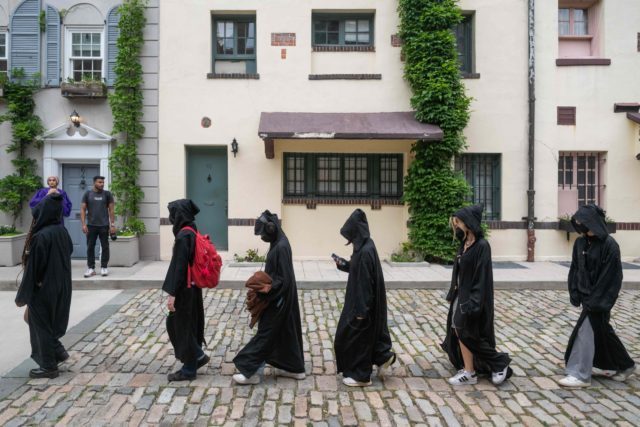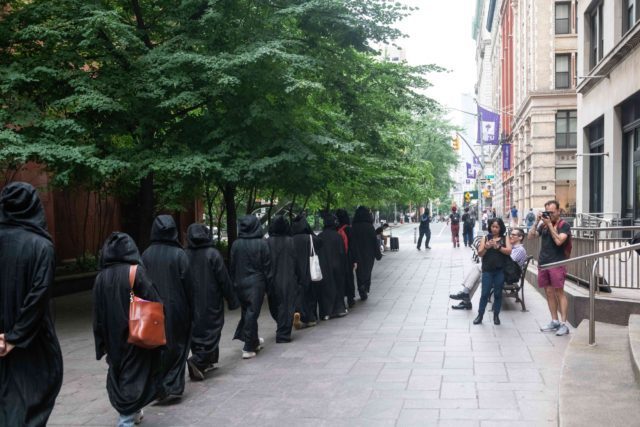
Pan Pan’s Cascando takes cloaked and hooded audiences through the Village (photo by Ian Douglas)
CASCANDO
NYU Skirball
566 LaGuardia Pl.
Through July 3, $35
nyuskirball.org
www.panpantheatre.com
“What are they!?” a young woman shouted on a recent early evening in Washington Square Park as we marched in a slow procession, more than a dozen people wearing long black cloaks and hoods. She wasn’t the only one confused by what was happening. As we took off from NYU Skirball, we had to wind past graduating seniors in purple robes celebrating with friends and family; hopefully they didn’t take our silent appearance as a sign of impending doom.
A few months ago, I experienced Chasing Andy Warhol, Manhattan-based Bated Breath’s immersive production in which a guide led an audience of no more than sixteen on a walk through Greenwich Village, encountering different manifestations of the Pop artist that played out in vignettes on the streets, where passersby could stop and watch and take photos and video even if they didn’t quite know exactly what was going on, though the multiple Warhols were obvious.
I went on a very different kind of theatrical walk last week, Dublin-based Pan Pan theater’s immersive, mysterious adaptation of Samuel Beckett’s early 1960s “radio piece for music and voice,” Cascando. We gathered, put on robes and headphones (under our hoods), and sauntered in formation as we listened to two thick, Irish-accented voices read Beckett’s words. In 1936, Beckett had written a love poem with the same title, which American poet Robert Pinsky, in comparing it to William Butler Yeats’s “Adam’s Curse,” explained in Slate, “More passionate than dismissive, too dire and skeptical to be read at weddings, yet ardent, these poems are explicitly in conflict with writing itself, yet embrace it.” Just like Warhol’s films, such as Kitchen and Empire, where narrative storytelling conventions are hard to find, much of Beckett’s work, including Cascando, does not incorporate standard plotting devices either. In essence, Cascando is about the art of storytelling itself, but only as Beckett can tell it.
The half-hour tale is told by Dan Reardon as Opener, Andrew Bennett as Voice, and Jimmy Eadie as Music, as Beckett equates voice and music, the former about meaning, the latter feelings. The first words we hear are Opener saying, “It is the month of May . . . for me,” as if it might not be for the rest of us. That is about as specific as the piece gets as it deals with starting and finishing, getting lost, vague memories, an abstract sense of place, and what goes on inside one’s head. The words spoken by Bennett lead right into Eadie’s tense, dramatic instrumentals, sometimes with extended breaks that can make you wonder whether the narration is over. (Marcel Mihalovici composed the original score.)
In their book The Collected Poems of Samuel Beckett, editors Seán Lawlor and John Pilling elucidate that the term “‘cascando’ is (rarely) used in music to distinguish a diminuendo in volume and/or tempo,” particularly as the end approaches. The repetitive text, however, doesn’t really have a beginning, middle, or finale, or at least not in the way theatergoers generally expect.
In a low panting, Voice begins, “—story . . . if you could finish it . . . you could rest . . . sleep . . . not before . . . oh I know . . . the ones I’ve finished . . . thousands and one . . . all I ever did . . . in my life . . . with my life . . . saying to myself . . . finish this one . . . it’s the right one . . . then rest . . . sleep . . . no more stories . . . no more words . . . and finished it . . . and not the right one . . . couldn’t rest . . . straight away another . . . to begin . . . to finish . . . saying to myself . . . finish this one . . . then rest . . . this time . . . it’s the right one . . . this time . . . you have it . . . and finished it . . . and not the right one . . . couldn’t rest . . . straight away another . . . but this one . . . it’s different . . . I’ll finish it . . . then rest . . . it’s the right one . . . this time . . . I have it . . . I’ve got it . . . Woburn . . . I resume . . . a long life . . . already . . . say what you like . . . a few misfortunes . . . that’s enough . . . five years later . . . ten . . . I don’t know . . . Woburn . . . he’s changed . . . not enough . . . recognizable . . . in the shed . . . yet another . . . waiting for night . . . night to fall . . . to go out . . . go on . . . elsewhere . . . sleep elsewhere . . . it’s slow . . . he lifts his head . . . now and then . . . his eyes . . . to the window . . . it’s darkening . . . earth darkening . . . it’s night . . . he gets up . . . knees first . . . then up . . . on his feet . . . slips out . . . Woburn . . . same old coat . . . right the sea . . . left the hills . . . he has the choice . . . He has only—” Opener responds, “And I close. . . . I open the other.” Then music.
Much of the rest of the text continues that pace and language, a story about a story about Woburn that opens and closes and veers off into puzzling tangents that occasionally relate to the procession. “Don’t lose him . . . follow him . . . waiting for night . . . night to fall,” Voice says, as if reminding us to stay right behind the person in front of us (our own personal Woburn, who is described as wearing the “same old coat”?) as, indeed, dusk approaches. “It’s in his head,” Opener points out, and of course, this is all happening inside our heads. The back-and-forth language is reminiscent of what the anonymous protagonist declares in Beckett’s 1953 novel The Unnamable: “You must go on. I can’t go on. I’ll go on.”

Poetic procession passes people who are perplexed, take pictures, or are simply nonplussed (photo by Ian Douglas)
As we go on, getting closer to the conclusion and are ambling determinedly through Greenwich Village back to Skirball, Opener says, “Then the return. Where? To the village.” During the journey, a few people stopped and took pictures or video, some cast sideways glances, curious about who we were and what we were doing, but mostly passersby just ignored us, as if there was nothing strange or different about our ceremony. One graduate laughed, put his purple robe over his head, and joined in for a few steps. Fortunately, no one threw rocks, which creator and director Gavin Quinn said had occurred when Cascando was presented in Düsseldorf. (It has also been performed at the Barbican London, the Beckett Festival in Enniskillen, the Galway International Arts Festival, and the Samuel Beckett Theatre in Dublin.)
I highly recommend fully immersing yourself into the walk and embracing designer Aedín Cosgrove’s costume; if you bring a purse, pocketbook, or shoulder bag, make it a black one, and try to keep it inside the cloak to avoid any bits of color forming a distraction. Also, even though you’ll be outside, wear a black mask to cover much of whatever part of your face is visible to others; it will add to the anonymity and enigma of it all as passersby ponder whether you’re in a demonic cult or en route to an Eyes Wide Shut sex party.
Beckett himself called Cascando “an unimportant work but the best I have to offer. It does I suppose in a way show what passes for my mind and what passes for its work.” Pan Pan, which has staged such other Beckett concoctions as Endgame, Quad, Embers, and All That Fall in addition to adaptations of William Shakespeare, Bertolt Brecht, Anton Chekhov, Henrik Ibsen, Aldous Huxley, and Oscar Wilde, has put together a unique pilgrimage with Cascando, a personal journey as well as an homage to Beckett, a melding of the interior and the exterior, held in an area of New York City bubbling over with life, promise, and hope.